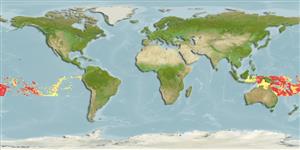Environment: milieu / climate zone / depth range / distribution range
Écologie
marin; eau douce; saumâtre démersal; catadrome (Ref. 51243); profondeur 0 - 3000 m (Ref. 86942). Tropical; 1°S - 25°S
Pacific Ocean: Sulawesi, Indonesia to the Society Islands. Also recorded from Pitcairn (Ref. 9828).
Taille / Poids / Âge
Maturity: Lm ? range ? - ? cm
Max length : 100.0 cm TL mâle / non sexé; (Ref. 9828); 165.0 cm SL (female); poids max. publié: 0.00 g
Vertèbres: 110 - 114. The only species that can be either variegated or plain-colored. Mottled individuals most closely resemble Anguilla celebensis and A. interioris in having broad, undivided tooth bands, but their ranges do not overlap. Plain-colored individuals most closely resemble A. japonica and A. borneensis, but those species both geographically distant. A. obscura is also plain-colored but has a shorter dorsal fin (Ref. 9828). The skin is grey to yellowish and more or less spotted with brown or black. It can be sometimes uniformly brownish red on the flanks and the back. The belly is white. Young specimens are grey and do not have spots (Ref.48622).
Found in rocky pools, often in coastal streams (Ref. 2847). No separate statistics available (Ref. 9828). The maximum weight (9,000 g) refers to the length (165 cm TL) of a female individual (Ref. 48622).
Life cycle and mating behavior
Maturité | Reproduction | Frai | Œufs | Fécondité | Larves
Smith, D.G., 1999. Anguillidae. Freshwater eels. p. 1630-1636. In K.E. Carpenter and V.H. Niem (eds.) FAO species identification guide for fishery purposes. The living marine resources of the WCP. Vol. 3. Batoid fishes, chimaeras and bony fishes part 1 (Elopidae to Linophrynidae). FAO, Rome. (Ref. 9828)
Statut dans la liste rouge de l'IUCN (Ref. 130435)
Menace pour l'homme
Harmless
Utilisations par l'homme
Pêcheries: commercial
Plus d'informations
PaysZones FAOÉcosystèmesOccurrencesIntroductionsStocksÉcologieRégime alimentaireÉléments du régime alimentaireConsommation alimentaireRation
Noms communsSynonymesMétabolismePrédateursÉcotoxicologieReproductionMaturitéFraiRassemblement de ponteFéconditéŒufsDéveloppement de l'œuf
RéférencesAquacultureProfil d'aquacultureSouchesGénétiqueElectrophoresesHéritabilitéPathologiesTraitementNutrientsMass conversion
Outils
Articles particuliers
Télécharger en XML
Sources Internet
Estimates based on models
Preferred temperature (Ref.
123201): 3.7 - 9.6, mean 4.9 °C (based on 415 cells).
Phylogenetic diversity index (Ref.
82804): PD
50 = 0.5000 [Uniqueness, from 0.5 = low to 2.0 = high].
Bayesian length-weight: a=0.00076 (0.00037 - 0.00155), b=3.17 (3.00 - 3.34), in cm total length, based on LWR estimates for this Genus-body shape (Ref.
93245).
Niveau trophique (Ref.
69278): 3.8 ±0.7 se; based on size and trophs of closest relatives
Résilience (Ref.
120179): Très faible, temps minimum de doublement de population supérieur à 14 ans (Preliminary K or Fecundity.).
Fishing Vulnerability (Ref.
59153): Very high vulnerability (90 of 100).
